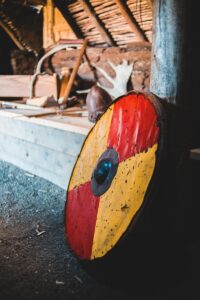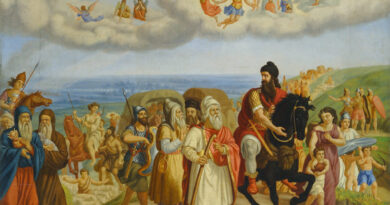Viking Sites to visit in Denmark
T he Danish Viking heritage is deeply rooted in the history and culture of Denmark, shaping the nation’s identity and leaving an indelible mark on the world. The Vikings, known for their seafaring skills, warrior spirit, and exploration, emerged from the Scandinavian region during the late 8th century and flourished until the 11th century.
he Danish Viking heritage is deeply rooted in the history and culture of Denmark, shaping the nation’s identity and leaving an indelible mark on the world. The Vikings, known for their seafaring skills, warrior spirit, and exploration, emerged from the Scandinavian region during the late 8th century and flourished until the 11th century.
Denmark, with its strategic location between the Baltic and North Seas, became a hub for Viking expeditions and trade routes. Danish Vikings, fueled by a spirit of adventure and a desire for wealth and conquest, embarked on voyages across Europe, the Mediterranean, and even as far as North America.
The Vikings’ reputation as fierce warriors was well-deserved. They employed advanced shipbuilding techniques to construct their iconic longships, which allowed them to navigate rivers, fjords, and open seas with ease. Their raids and invasions struck fear into the hearts of many, as they attacked coastal settlements, monasteries, and trading posts. However, the Danish Vikings were not solely focused on plunder; they also established settlements, traded goods, and formed alliances with local communities in their newfound lands.
Beyond their military prowess, the Danish Vikings were skilled craftsmen, excelling in shipbuilding, metalworking, and intricate woodcarving. They created masterpieces of art, such as the famous Jelling stones, which were large rune-inscribed stones that served as markers of significant events and achievements.
The Viking Age saw the rise of legendary Danish figures, such as King Harald Bluetooth, who united the Danish tribes and introduced Christianity to the region, as well as the great warrior King Cnut the Great, who ruled over a vast Viking empire encompassing England, Denmark, Norway, and parts of Sweden.
Today, the Danish Viking heritage is celebrated and preserved through archaeological discoveries, museums, festivals, and historical reenactments. The National Museum of Denmark houses an impressive collection of Viking artifacts, providing a glimpse into the lives and accomplishments of these formidable seafarers.
The influence of the Danish Vikings can also be seen in the modern Danish society. The Danish language, with its rich vocabulary and grammar, has its roots in the Old Norse spoken by the Vikings. The Danish flag, the Dannebrog, is said to have descended from the sky during a battle fought by Danish warriors in the 13th century, symbolizing their Viking heritage and resilience.
For a traveller there are some interesting sites to visit.
Trelleborg Viking Fortress
The Trelleborg Viking Fortress is one of the most significant Viking heritage sites located near Slagelse in West Zealand, Denmark. This fortress is a testament to the Viking Age and offers a unique opportunity to experience it firsthand.
History
Constructed around AD 980 by King Harald Bluetooth, Trelleborg is one of the Vikings’ great ring fortresses. The fortress is situated in the picturesque area of Tude ådal. The museum at Trelleborg houses models, archaeological finds, and reconstructions that provide a vivid impression of its history, the people who lived there, and the fortress’s function.
Activities
Visitors can immerse themselves in the lives of the Vikings at the reconstructed village of Slagløse. During holidays, Trelleborg offers a wealth of activities, displays, and events. Visitors can try their hand at Viking crafts and daily tasks such as baking flat bread, firing a Viking longbow, painting a shield or a sword, carving their name with ancient Viking runes, or casting jewellery made of tin.
Events
Trelleborg hosts a Viking festival annually during week 29. The festival offers a captivating historical experience and a chance to fully immerse oneself in the Viking era.
UNESCO
The Danish Ringfortresses, including Trelleborg, are being considered for World Heritage status. This recognition would further highlight the significance of these sites in Viking history and global heritage.
Visiting Trelleborg Viking Fortress offers a unique opportunity to step back in time and experience the Viking Age in an authentic and engaging way.
Fyrkat Viking Fortress
Fyrkat is another prominent Viking heritage site located near the town of Hobro in Northern Jutland, Denmark. This former Viking ring castle, dating from around 980 AD, is situated some distance from the present end of the Mariager Fjord.
History
Fyrkat was built during the reign of King Harald Bluetooth, around the same time as the Trelleborg fortress. The fortress is designed as an exact circle with four gates opposite each other, connected by two wooden roads that cross at a right angle in the middle of the fort. The fortress was strategically located to control the traffic on the main land route between Aalborg and Aarhus.
Layout and Construction
The fortress’s inner diameter is 120 meters, and the width at the base is 12-13 meters. It was constructed with three rows of vertical wooden poles, each connected to the next ring by beams. The fortress contained 16 identical longhouses arranged in a square, each 28.5 meters long and 5 meters wide at the ends, expanding to 7.5 meters in the middle. The walls of the longhouses consisted of double rows of posts with planks wedged horizontally between them.
Cemetery
The site also includes a cemetery with a total of thirty burials in various states of preservation. The graves are all inhumations oriented in an east-west direction. Some of the objects found in the graves include coffins, daily goods, fabrics, and jewelry. Several more unusual containers used for holding the body were also found; these include a cart and a chest. The graves were identified as belonging to children if the size of the grave was less than 150 cm. The gender of the remains in a grave is typically dictated by the objects found with it.
Excavation and Finds
The site was excavated between 1950 and 1958 by the Architect and Museum Inspector C.G.Schultz. The ramparts, that had almost been ploughed level through the ages were piled up again and the postholes of the roads and buildings were filled with concrete. The museum at Hobro houses most of the things found at Fyrkat.
Viking Center Fyrkat
In 1993, the visitor center of Viking Center Fyrkat was built about one kilometer from the ring fort. The center resembles a large Viking farm, a big longhouse, a smithy, a barn, and some smaller buildings including exhibition buildings and a museum shop – nine buildings in total. The center aims to present a complete Viking Age environment, modeled after a supplier for the fort. This includes regular re-enactments and various activities involving curious and willing visitors.
Today
Today, Fyrkat offers a unique opportunity to step back in time and experience the Viking Age in an authentic and engaging way. The reconstructed longhouse and the Viking Center provide a vivid impression of the life and times of the Vikings. The site’s historical significance and the ongoing efforts to preserve and present its history make it a must-visit destination for anyone interested in Viking history.
In conclusion, both Trelleborg and Fyrkat Viking Fortresses offer unique insights into the Viking Age in Zealand, Denmark. They provide a glimpse into the architectural prowess, strategic planning, and daily life of the Vikings. Visiting these sites is not just a journey into the past, but also an educational experience that brings history to life.




